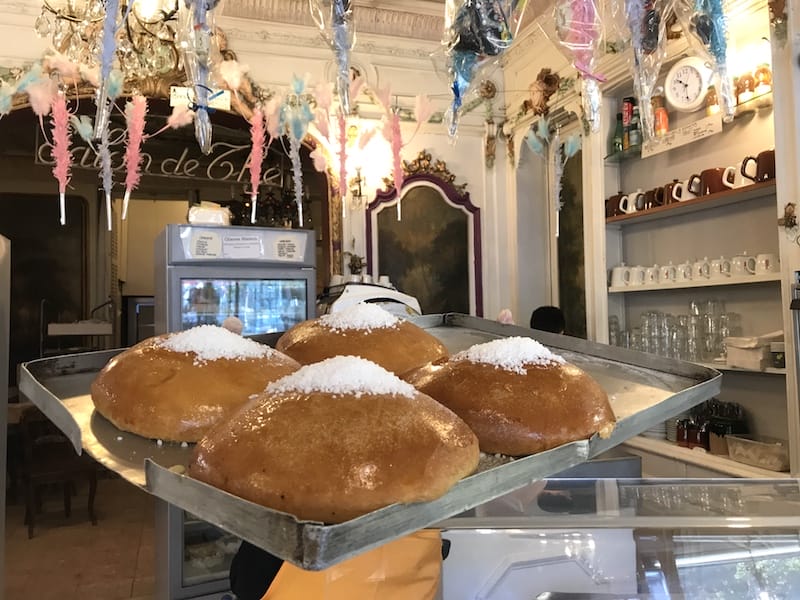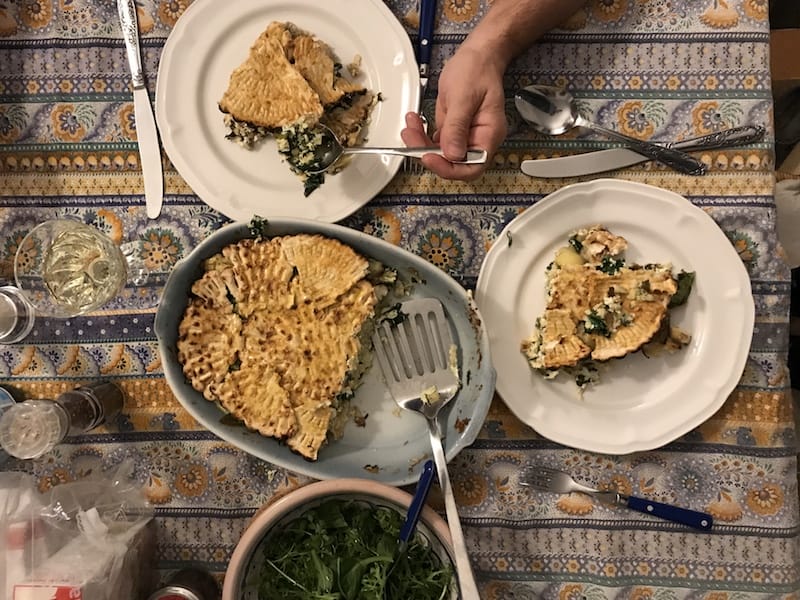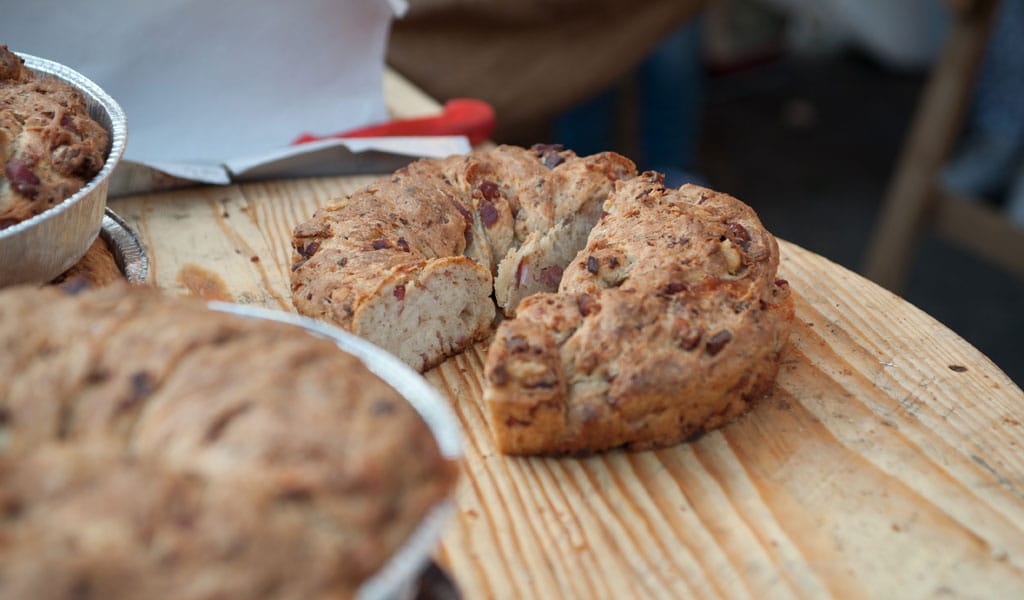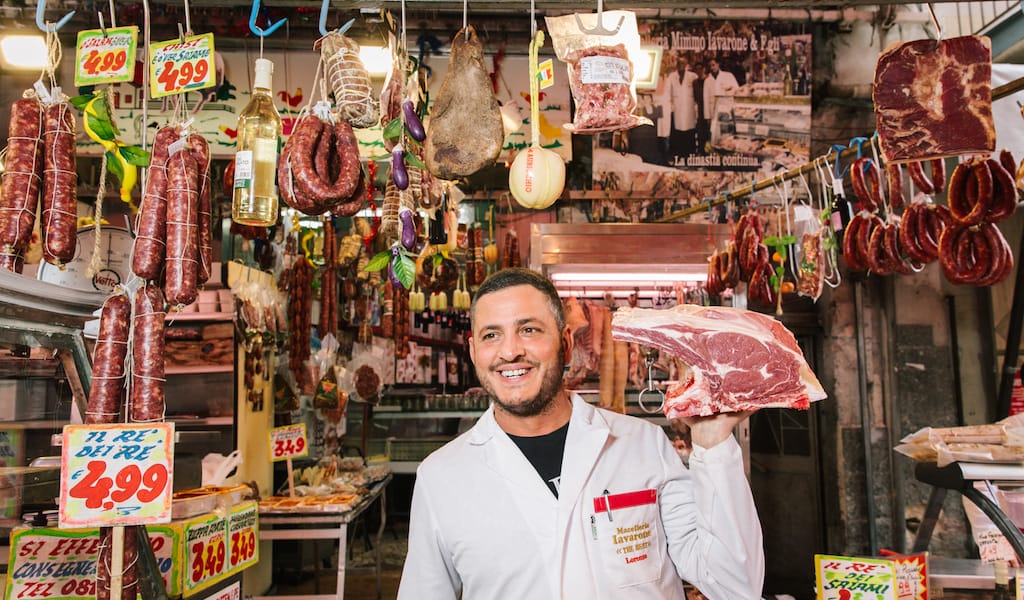Growing up with a Midwestern Protestant mom and a Montreal-born Jewish dad, my family’s holidays wove together traditions, much like a braided challah bread. We topped our Christmas tree with the Star of David and served matzo at Easter brunch. More cultural than religious, our celebrations weren’t restricted to one faith or another. What mattered was the meaning: respecting our roots through ritual and thoughtfully gathering together around the table.
Now living in multicultural Marseille, I still celebrate with the same interconnected spirit. Here, the similarities of the springtime holidays abound. For starters, they are semantic cousins, with Passover, Pâque juive, known as “Jewish Easter” in French. On Pâques, Provençal tables are topped with platters of oeufs mimosas. Named for the iconic yolk-yellow flowers that bloom across the region, these deviled eggs are the same as those served at many Passover seders in Marseille.
The affinity among the fêtes is perfectly illustrated by one baked good: the mouna, a sugar-studded brioche baked by Algerian Jews to celebrate the end of Passover. Brought over to southern France after Algeria’s independence, it is now the customary Easter dessert in Marseille.
Celebrating during the Covid-19 lockdown has taken on a different tone. It’s the first time I didn’t host a big group, spend the whole day cooking, and then overeat due to the abundance of said feast. I held the smallest seder I’ve ever known with just me and Sauveur, my franco-sicilien beau whose passion for the New and Old Testament’s stories would make any rabbi or priest swoon. How could he not be spiritual when his name means “savior” in French?
Though sad to be an ocean apart from my extended family, this pared-down holiday has allowed us to honor the new family we are creating together. One that, like my parents’, brother’s and sister’s relationships, blends diverse backgrounds into a flavorful stew. Like the bowls in which I served the seder’s matzo ball soup – the hand-painted Sicilian ceramics were inherited from Sauveur’s late father. In their colorful motifs, I spot a Jewish star while he sees the seal of Solomon. Both ring true in our co-mingled world.
In the holiday spirit of sharing food and stories, I wanted to highlight customs from Marseille, France, and beyond. These traditions connect us – just like the communal confinement we are all enduring during in this time of the coronavirus.

The sacrificial lamb
In France, lamb is the chosen dish on Easter, to commemorate the suffering on the cross that Jesus, the “lamb of God,” endured. Sephardic Jews also eat agneau, but for a different sacrifice, that of the lamb whose blood stained doors to prevent the plague of the “slaying of the first born,” just prior to the exodus from Egypt. To take advantage of Easter and Passover falling in the same week, I decided to make one lamb dish for both. My Bubby, who likened time-consuming recipes to “wasting time,” would have been proud of my resourcefulness.
Provence is prized for its agneau de Sisteron, a free-range heritage lamb that frolics beneath the verdant Southern Alps. I nestled my lamb shoulder Provençal style, along fresh-picked thyme and rosemary and garlic cloves in the ne plus ultra of cookware, a cast-iron cocotte. Then, I cooked it low and slow, the classic seven-hour French technique in which the meat is so fall-off-the-bone tender you could eat it with a spoon (à la cuillére). The springtime crops of asparagus and peas are also on the menu in Provence. As is a crisp Romaine lettuce salad, which food writer Pierre Psaltis says is a “nod to Marseille’s Roman past.”
A culinary divide
Though I was raised on brisket, my Marseille friend Judith told me her family fetes with lamb and fava bean tagine. They hail from northwest Algeria and eastern Morocco. Like most of Marseille’s Jewish community – at 80,000, it’s Europe’s third largest – she’s Sephardic (whereas my Moldovan grandfather makes me Ashkenazi).
While these two Jewish subcultures are quite analogous, their diets are quite different due to their distinct terroirs. Ashkenazi cuisine consists of stick-to-your-ribs dishes like smoked meat, gefilte fish, and kugel, a noodle casserole, that keep you warm in the winter. Sephardic cooking is the colorful counterpart to these monochromatic plates. Bright salads, simmering stews and rice dishes brimming with chickpeas and tomatoes and flavored with Mediterranean spices like cumin, sumac and preserved lemon.
The seder spotlights this culinary divide. Ashkenazi matzo balls – dumplings made from ground matzo – are served in chicken soup, while the Sephardim fry and dip theirs in honey for sferies donuts they gobble up with their hands. During the Passover week, the Sephardim tuck into vegetable soups and tagines that make the most of fava beans, peas and seasonal bounty. My friend’s neighbor with Moroccan roots, Josselyne, likens the non-wheat, veggie-heavy diet to a “lovely springtime cleanse.” A spring-cleaning for our bodies, just like we’re doing with our closets while being cooped up in our homes.
Brick by brick
Charoset is the stuffing of the seder table. Every family has their own recipe – the common ingredient is the sweetness to balance the bitter herbs that accompany it. I grew up with the Ashkenazi version: a mix of apples, walnuts, cinnamon and Manischewitz, the sticky sweet wine that is more closely related to Welch’s grape juice than a fine Burgundy. Sephardic versions trade the cooler climate apples with Mediterraenan dates, figs, and dried fruits.
Inspired by my Algerian-run spice shop in Marseille, I made mine with dried dates, figs and apricots, added chestnut purée and cognac for Frenchiness, and grated the zest of oranges my boyfriend had brought back from Sicily. Since charoset symbolizes the mortar the enslaved Jews made into bricks, the Sephardim like to purée theirs to have a clay-like texture. I like the chunkier version – like peanut butter, everyone has their preference.
3/4 cup of each: dates, figs, and apricots – coarsely chopped
1 ½ cup of walnuts, coarsely chopped
2 tablespoons chestnut paste
Zest of 1 orange
1 tbsp of brandy or cognac (optional)
Honey to taste
Mix the first four ingredients together in a bowl. Add the alcohol and the honey – more if needed – until the mixture sticks together. If you have leftovers, I like charoset spread on matzo for an afternoon snack or scooped on yogurt for breakfast.

I can’t believe its matzo
I was worried about avoiding bread for eight days in a country that consumes 10 billion baguettes a year. Within a kilometer of my apartment alone there are three boulangeries, and it’s common for the scent of baking loaves to waft into the street. Then again, the supermarket shelves have been sold out of flour for weeks. If there’s a positive to the pandemic, it’s the lack of flour to tempt my baking cravings during Passover.
Matzo, the unleavened bread of Passover, is an unsavory substitute, with its oftentimes cardboard-like texture, bland taste and tendency to put the brakes on your intestinal tract. And then I discovered La Bienfaisante matzo. Made in southwest France from “recipes used in Algeria” (as it says on the box), these lacy, round doilies look like they were hand-carved by Maghreb artisans. A far cry from the usual tasteless squares, these deliciously thick matzos merit their name: galettes, the French word for shortbread or pancake.
With these Oran-born beauties, I don’t miss my baguette. I didn’t even want to drown them in butter in matzah brei, the beloved Ashkenazi scrambled egg and matzah dish. So, I made like a Mediterranean and made my first mina, a Sephardic layered pie that subs in matzo for lasagna noodles to keep it Passover-friendly. This recipe from one of my favorite Jewish cooking bloggers was so good it’s on the menu for the next seder – or, suggests Sauveur, dinner any night.
Breaking bread
After the sacrifice of abstaining from bread, some Maghrebian Jews host a post-Passover carb fest: Mimouna. Once the sun sets on the last night of Pesah, doors open to welcome families and friends to feast on the aforementioned mouna, honey-soaked pâtisseries orientales, or heaping platters of couscous with fava beans like Judith’s family does. Mimouna began in Morocco, where friend-of-a-friend Josselyne’s earliest childhood memories are of festive nights when the community brought their laden tables outdoors to gather together under the stars.
Sometimes, Muslims offer baked goods to their Jewish neighbors since it is forbidden to have flour in the house until Passover is officially over. Though now popular in Israel, Mimouna isn’t widely known in France, save for some Sephardim families who continue the tradition within their homes. Next year when we’re (hopefully) permitted to commune again, I’m planning to rekindle the tradition in Marseille.
This article is originally published on April 17, 2020.
 April 13, 2020 Home for Easter
April 13, 2020 Home for Easter
A famous Italian saying goes, “Christmas with yours and Easter with whomever you want.” […] Posted in Naples April 30, 2019 Meet the Vendors
April 30, 2019 Meet the Vendors
Being a street butcher in Naples is not for the faint of heart. “Rain, sun, wind, heat, […] Posted in Naples April 2, 2024 Grandma’s Folar Recipe
April 2, 2024 Grandma’s Folar Recipe
Folar is the generic name given to traditional Easter sweet bread in Portugal. Making it […] Posted in Lisbon
Published on April 15, 2022
Related stories
April 13, 2020
NaplesA famous Italian saying goes, “Christmas with yours and Easter with whomever you want.” Well, this year there wasn’t much of a choice: Easter was spent at home, with family. The lockdown in Italy has largely coincided with Lent (the 40 days leading up to Easter, from Ash Wednesday to Holy Saturday). Except that this…
April 30, 2019
NaplesBeing a street butcher in Naples is not for the faint of heart. “Rain, sun, wind, heat, cold… being on the street seven days a week means knowing how to face every type of weather,” says Gaetano Iavarone. He is part of the invincible team behind Macelleria Iavarone, a butcher shop in Naples’ Sant’Antonio Market…
April 2, 2024
LisbonFolar is the generic name given to traditional Easter sweet bread in Portugal. Making it from scratch is somewhat of a long process, but being confined due to the coronavirus crisis, we seem to have a bit more time on our hands than expected. My family’s folar recipe is from my grandmother Felismina, who was…


















































































